Men's magazines: an A to Z
Men's magazines, lads' magazines, glamour magazines, pin-up magazines and top-shelf magazines are covered on these pages. This page is arranged alphabetically from Fable to Front, via FHM and Fiesta. On other pages:Introduction
- 3D titles to Boys Toys
- Carnival to Cut
- Deluxe to Esquire
- Fable to Front (this page)
- Fable to Front
- The Gentleman's Magazine to The Humorist
- Ice to London Opinion
- Man to Maxim
- Mayfair to Monkey
- Nine to Playboy
- Razzle to Stuff
- T3 to Zoo Weekly
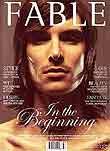 |
Fable [closed]Queercompany, London, November 2001-?. Editor Jonathan Keane.'Queer life, story and style'. Targets gay men and women. |
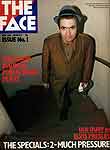 Nick Logan's The Face first issue with Jerry Dammers of the Specials on the cover (photo: Chalkie Davies)
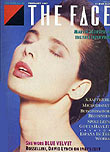 The Face style bible: this cover is of Isabella Rossellini in David Lynch's Blue Velvet  The Face had a lacklustre time at Emap. Kelis & Andre 3000 were on the final cover (issue 88 of volume 3) |
The Face [closed]Wagadon/Emap, May 1980-May 2004The Face was launched by Nick Logan in May 1980, calling itself 'a visual-orientated youth culture magazine' and was the sort of magazine he wanted to read. Logan had edited music weekly New Musical Express for IPC and invented pop weekly Smash Hits for Emap. This background showed in the music focus of the early issues. However, the content expanded to cover design, fashion and media and The Face became the leader of a trio of style magazines – Blitz and i-D being the rivals).It was in the right place – and later found the right designer in Neville Brody – to become the 'house magazine' of the New Romantics, Boy George and the clubbing scene. By the late 1980s, The Face had become a style bible for the under-25s and was selling 88,000 copies a month Logan went on the launch Arena for readers
who had outgrown The
Face. However, the failed launches of Deluxe and Frank
forced Logan to sell out to Emap in 1999. In March 2004,
Emap announced the closure of The Face, citing the
changing marketplace and falling sales. Only i-D survives
of the original style trio. |
 Fanfare with Pat Arnold on the cover of the first issue
|
Fanfare [closed]Town & Country Publications (Toco), Croydon, Surrey. 1958-?1/3. 44pp. Editor: Robin Brewster; picture editor: Marjorie Smith The first issue in January 1958 was subtitled 'The adventures of a glamour girl'. Pat Arnold, a beautician from Hertfordshire, was the featured glamour girl |
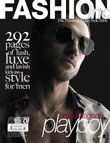 Fashion Inc: an attempt to take Loaded Fashion more upmarket
|
Fashion IncIPC Media, Spring/Summer 2006Editor Adrian Clark took Loaded Fashion and relaunched it in a bigger, glossier package. Tag line is: 'The thinking man's style bible.' Editorial focus is on high fashion, luxury accessories and grooming. Interiors and personal technology also covered. The target audience is 'affluent AB males, aged between 25 and 45: urban professionals with separate wardrobes for work and play'. IPC profile |
 FHM: March 2003 cover pushing the High Street Honeys competition. A
year later, the magazine used a special drop-down cover to promote the winner, as below
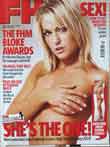 FHM Feb 2004 issue held a surprise ...  ... it dropped down to reveal High Street Honey 2003 Kayleigh |
FHM / For Him [closed]Emap, 1995-2008; Bauer, Jan 2008-2015For more than a decade, FHM was the best-selling men's title, but in 2009, it lost that mantle to Men's Health. Its circulation had shrunk from 775,000 in 1998 to 235,027 in the first half of 2009. As part of its attempt to turn the title round, Bauer had started to call it a 'lifestyle title' rather than a 'lads' mag'. Men's Healthpublisher Alun Williams claimed: 'The era of lads' magazines is over.' In 2007, FHM appointed four agony uncles – each aged more than 100 – called the "centurions", to answer questions from readers. These included Harry Patch, then 109, who was Britain's last surviving soldier of the Great War when he died two years later.Back in 1995, while James Brown at IPC was preparing to launch lads' magazine Loaded, Emap bought the 76,000-circulation fashion title FHM from small publisher Tayvale (see For Him). Mike Soutar set about the relaunch with publisher David Hepworth. Soutar developed ways of differentiating his title from the then market-defining Loaded through taking a very practical approach. In his view, Loaded offered lads the chance to live life through the writers as they 'drink and snort their way through endless freebies'. Arena and GQ seemed 'impossibly cool for the average bloke'. He took Brown's philosophy, but added a dimension – everything in FHM had to be accessible to readers. In a Guardian interview (17 February 1997, page 7), he espoused a 'mantra' that everything in the magazine had to be: 'funny, sexy, useful'. Writers could never cover any activities that readers couldn't also take part in. So phone numbers and addresses were to be found at the end of most articles. In retrospect, this sounds simple, but Soutar's relaunch was in a highly competitive sector, in which IPC, Conde Nast and National Magazines were already active.The men's lifestyle market grew by almost half from Jul-Dec 1995 to Jul-Dec 1996. In that time, Loaded's sales grew by over 85%. Yet even this was not enough to outshine FHM: its sales more than doubled to 365,341. It was now rivalling the best-selling women's monthlies. By the end of 1999, FHM was selling 775,000 copies in the UK, and had been launched in five countries. The lads' magazines – lad mags – were taking over the world. However, sales tailed off, particularly with the advent of weekly lads' mags in Nuts and Zoo. From then on, all the monthlies lost their younger readers and have tried various strategies, with little effect, to keep sales up. In the first half of 2007, FHM sold 311,590 copies a month, down 25.9% year-on-year. In June 2007, Ed Needham – after seven years in New York editing FHM, Rolling Stone and Maxim returned to the UK and wrote in the Guardian:'... the internet, other electronic distractions and the UK weeklies have made the month a terribly unfashionable unit of time, and the path ahead for men's magazines increasingly difficult to chart. Of greater concern, it had stopped being fun. This genre, into which I had gleefully poured my heart and soul for so many years, had lost its appeal.'Yet, the success of the British titles had inspired publishers around Europe and the rest of the world. Maxim and FHM were widely licensed. By September 1999, FHM was the top men's title in the UK, Singapore, Australia, Malaysia and Turkey, and was about to appear in France. In February 2000, Ed Needham launched the US edition (Mar/Apr cover date). However, Emap's excursion in buying publisher Petersen was a disaster and Emap pulled out of the US, leaving only FHM to soldier on – and that was closed in early 2007 (March cover date). India marked the 31st international edition in October 2007 in a joint venture with Next Gen Publishing. There were many versions of the website, among them:
Emap profile |
 FHM Bionic was launched in 1999 (above), closed and came back to life in late 2008 dated Spring 2009 (below)
 |
FHM Bionic [closed]Emap Consumer Mags / Bauer. Dec 1999 (Win 99/Spr 2000 cover date) – Dec 2001; spring 2009 (one-off)Bauer revived FHM Bionic as a one-off with a spring 2009 cover date. The title then appeared again as the second half of the September 2009 issue of FHM . Launched in 1999 as a twice-yearly FHM spin-off aimed at 'healthstyle' market with contents based around health, fitness, adventure travel, sports fashion, grooming, sex and relationships. First issue cost £2.99 for 188 pages with William Drew as editor. Published twice a year with an initial print run of 175,000 copies. Followed FHM Collections, a bi-annual fashion and grooming title launched in 1998.The target was a 100,000 settledown circulation. It achieved 98,000 and in early 2001, FHM editor-in-chief Anthony Noguera announced plans to take it monthly against Rodale's Men's Health (which sold 235,800 copies). It hit the streets in August 2001 with Phil Hilton as editor but flopped to 45,000 sales and was closed in December. In December 2008, Bauer Media, which had recently taken over Emap, relaunched FHM Bionic at £4 with a print run of 80,000. Editorial covered health, nutrition, fitness, grooming and participation sports. In the first half of 2009, Rodale's Men's Health was the best-selling men's title, shifting 250,247 copies a month; Men's Fitness sold 67,987 for Dennis. FHM itself sold 235,027 copies.see FHM |
 FHM Collections was the fashion spin-off from the lads' mag
but closed in 2006 (first issue autumn 1998 above)
|
FHM Collections [closed]Emap / Bauer, Autumn/Winter 1998/99 – Autumn/Winter 2006 (biannual); October 2009(strap-on) Bauer revived this style magazine when FHM Collections was bundled with the October 2009 issue of FHM. It was part of a two-for-one strategy by Bauer, which had bundled another revival, health and fitness title FHM Bionic, with the previous issue. Both Bionic and Collections were planned to be published twice a year with FHM. The twice-yearly FHM spin-off was launched in September 1998 with a print run of 130,000 and Ed Needham as editor. It followed the launch of Loaded Fashion by IPC the month before.Emap signed a deal with Channel 5 for a one-off masthead programme, FHM Preview, based on Collections. However, it did not work out (Campaign, 21 May 1999, p8): It makes no sense for general interest magazines to become involved in masthead TV programming, [said] Phil Thomas, managing director of Emap Metro's FHM. 'I can't see it doing anything other than costing us a lot of money,' he said. 'I have yet to see a business plan that shows it makes business sense.' Thomas expressed disappointment with FHM's recent collaboration with Channel 5. 'We wanted it to be specifically about fashion and style – more of a spin-off of our magazine, FHM Collections. Channel 5, understandably, wanted it to be as broad as possible. 'So there was a certain amount of tension there, and the result was a bit of a compromise between the two.'In the latter half of 2000, Collections was selling 71,064 copies. However, sales faltered and in April 2006, Emap announced its closure, saying the market was too small with a circulation of about 50,000. Collections launched its own branded watch. They can be found on Ebay for about £10. |
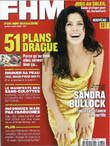 FHM France in July 1999 |
FHM FranceEmap France / Mondadori. July 1999-US actress Sandra Bullock was on the July 1999 launch cover along with the headline '51 plans drague' – 51 ways to pull. Emap profile |
 FHM launched in the US with actress Rachel Leigh Cook as its cover girl
|
FHM US [closed]Mar-Apr 2000 – Mar 2007Ed Needham launched the US edition but Emap's excursion in buying publisher Petersen was a disaster and Emap pulled out of the US, leaving only FHM to soldier on – and that closed in 2007. The cover girl on the first issue was US actress Rachel Leigh Cook. For the last issue (no 76), Scott Gramling was editor and model Leeann Tweeden was on the cover. Emap profile |
 Fiesta launched in 1956  Fiesta: issue 3 with Sylvana Manto on the cover by Russell Gay  Spring 1957: still a pocket title  Fiesta (Feb 1967), the 12th issue after the title's relaunch by top-shelf publisherGalaxy  A 1979 Fiesta cover |
FiestaGannet Press (Sales) Ltd, Birkenhead / Galaxy. Monthly. June 1956-59?; 1966-Fiesta was launched as a monthly pocket title in the glamour magazines mould. Was also distributed to the Continent through the Netherlands and Denmark. Issues included a reply-paid tip-on mini post card to vote for photo of the month taken by readers (£25, £5 and £2/10/0 prizes). Colour pages were a feature, especially in the quarterly specials (which were priced at 3/6 as opposed to the monthly 2/6). The August 1956 issue (left) featured the 8 centre pages in colour, in addition to the covers. The inside front cover was of Rita Landre, alter ego of Pamela Green, by Harrison Marks. There was also a page photo of Pamela Green. Sylvana Manto was on the cover and inside by Russell Gay. The spring 1957 special (left) had 12 colour pages out of 80, including the cover and the centre spread. Photographers included Harrison Marks, Russell Gay, Eva Grant, 'Taff' and Royston Campbell. None of the models was topless. The pocket monthly seems to have fizzled out in 1959.In 1966, the Fiesta title reappeared from soft-porn publisher Galaxy in an A4-ish format. Almost all the images showed nipples, apart from the covers. It soon claimed to be 'the fastest selling magazine for men'. By 1988, Fiesta was the UK's biggest-selling men's title at 328,000, a figure that put it in the top 25 of magazine sales. However, by 2001, sales had slumped to 73,685 copies a month. Galaxy also published Best of Fiesta specials. |
 For Him: 'style, grooming and fitness'  Andie MacDowell in FHM in April 1994 (the year Mike Newell's Four Weddings and a Funeral came out) |
For Him / FHMTayvale, 1987-1995- (then FHM)Chris Astridge started distributing For Him through men's fashion outlets. Distribution was expanded to newsagents as a quarterly in the spring of 1987. It was fashion-based and tended to be seen as a gay magazine, which was then a turn-off for other men. Emap bought the title and used it to thrash pioneer Loaded in the lads' magazines sector. |
 Foto launch issue in 1955  Foto (issue 23) with a Pamela Green cover by Harrison Marks  Foto (issue 43) |
Foto [closed]Axtell Pubs Ltd, Axtell House, Warwick Street, London W1. Blocks by Viaduct Process, Printed by Dyson Bros, Peterborough. Ed: John E Cross. 1955-? (ran to at least 45 issues).‘Through these pages pass the most beautiful girls in the world,’ ran the editorial, describing Foto as an international magazine of photographic art. Issue 23 here cost 1/6 for 56 pages.The cover of Pamela Green and colour centre spread were by Harrison Marks. It carried a back-page advert for Beat – 'Britain's fastest selling music magazine'. |
 Front: launch issue of the men's magazine with 3D specs 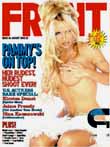 Pamela Anderson on Front magazine in 2002 |
FrontCabal/Highbury/Remnant/Flip, November 1998-Front always carried plenty of cleavage, boasting a '3D babefest poster' on its first issue. It was labelled as 'Loaded for teenagers'. This led to criticism, given the semi-pornographic nature of lads' magazines. The building society Nationwide refused to advertise; and supermarkets Sainsbury's and Asda returned 24,000 copies of the launch issue. However, Cabal said the whole 400,000 print run was sold. Cabal was taken over by Highbury, which in turn was split up in 2005, with Front going to SMD Publishing, a company set up by adult magazine publisher Remnant to buy Front, Hotdog and DVD World from Highbury. However, SMD went into administration at the end of 2006 and the title closed for 3 months before reappearing under Flip Media. Cabal profileSMD/Remnant profile |



